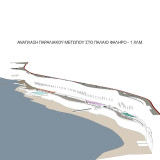Given the rapid pace of everyday life and the alienation of man from nature, this thesis focuses on creating a new design that aligns with new living conditions. The project revolves around the redevelopment of the coastal area of Paleo Faliro (1km), in order to eliminate the height differences and to provide direct access to the beach for residents and visitors, effectively eliminating the boundary between the city and nature. The main axis of the redevelopment is the water. The building structures will be based on this core axis as well as on the forms they can take and the surfaces they can cover. This design will address both the pedestrian walkway and the beach level. In a pragmatic assessment and with the analysis and mapping of the current situation, certain existing uses are retained while undergoing adjustments. Particular attention will be given on the treatment of the boundary through a combination of enclosed and open spaces and the creation of atriums, that will facilitate gradual transitions from private to public areas. Three building complexes are proposed at the beach level, designed in a way that the water will seep into them while parts of these buildings will extend into the water with lightweight structures, such as platforms. Furthermore, the pedestrian walkway will be widened in certain places, creating the concept of a “plaza”, a gathering square. The project will feature programmes such as wellness, rehabilitation and water-based recovery areas. It will also include recreational and activity zones for relaxation as well as all essential building facilities to ensure the proposal functions effectively as a cohesive whole.
